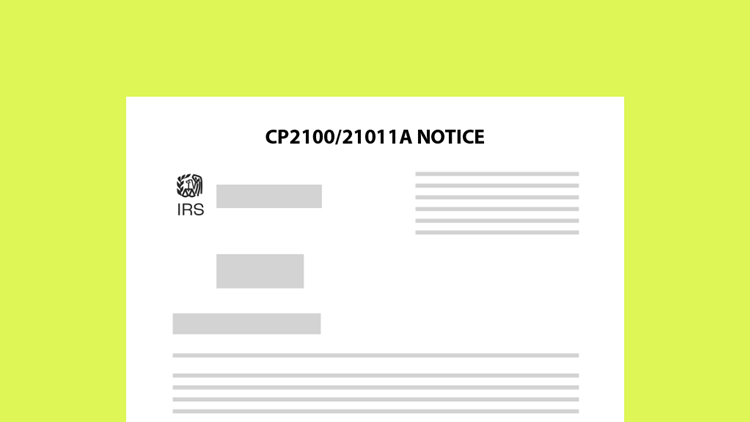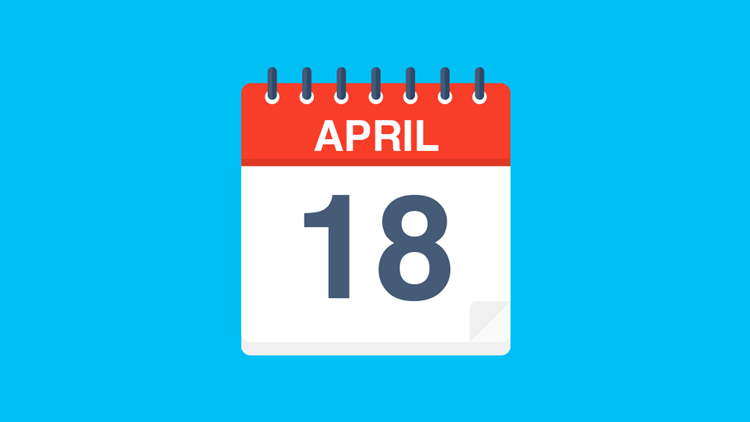by Ameritax | Apr 19, 2022 | Tax Tips and News
The Internal Revenue Service is giving some filers a firm but friendly tap on the shoulder, letting them know some of the forms they’ve filed don’t match up with the agency’s records.
Financial institutions, businesses or even regular individual taxpayers could see a notice in the mail. The notices, CP2100 or CP2100A, go out twice a year from the IRS, notifying taxpayers that their information return is missing a Taxpayer Identification Number (TIN), has an incorrect name—or has a combination of the two issues.
The notices first go out in September and October, then a follow-up mailing goes out in April the following year.

The information returns covered by these notices include:
- Form 1099-B, Proceeds from Broker and Barter Exchange Transactions
- Form 1099-DIV, Dividends and Distributions
- Form 1099-G, Certain Government Payments
- Form 1099-INT, Interest Income
- Form 1099-K, Payment Card and Third-Party Network Transactions
- Form 1099-MISC, Miscellaneous Income
- Form 1099-NEC, Non-Employee Compensation
- Form 1099-OID, Original Issue Discount
- Form 1099-PATR, Taxable Distributions Received from Cooperatives
- Form W-2G, Certain Gambling Winnings
Each notice has a list of people who were paid—or who received other types of income payments—and identifies the type of TIN issues the payee has.
The IRS says payers who get these notices should compare the accounts listed on the ÇP2100 and the CP2100A with their account records so the records can be corrected. Checking backup withholding on payments made to payees can also be part of the inspection and correction process.
Backup withholding
Taxpayers who get these notices are told that they are responsible for backup withholding and the payments listed on the filed information returns are subject to backup withholding under certain circumstances.
If a taxpayer has made payments and reported those payments on one of the information forms already discussed, they could be responsible for backup withholding if any of these statements hold true in their case:
- The payer does not have the payee’s TIN when making the reportable payments.
- The payee does not certify their TIN as required for reportable interest, dividend, broker and barter exchange accounts.
- The IRS notifies the payer that the payee furnished an incorrect TIN and the payee does not certify their TIN as required.
- The IRS notifies the payer to begin backup withholding because the payee did not report all their interest and dividends on their tax return.
The IRS reminds that payers are still liable for any amount they failed to backup withhold and penalties may apply in addition.
For more information on backup withholding and how to help payers comply, see Publication 1281, Backup Withholding on Missing and incorrect Name/TINs on the IRS website.
Source: IR-2022-87
– Story provided by TaxingSubjects.com
by Ameritax | Apr 16, 2022 | Tax Tips and News
The Internal Revenue Service is continuing in its effort to give taxpayers the very latest information right up to the end of tax season, by updating its frequently asked questions (FAQs) for the 2021 Rebate Recovery Credit a second time this year.
The updated portions are spelled out in Fact Sheet FS-2022-27 on the IRS website. The updated material concentrates on Topic F: Receiving the Credit on a 2021 Tax Return.

RRC could be a door to EIP
Those individuals who either failed to get the full amount third Economic Impact Payment (EIP) also termed a “stimulus payment,”—or failed to qualify for the EIP—may still be able to claim the Recovery Rebate Credit on their 2021 income tax return.
The third Economic Impact Payment was, in fact, an advance payment of the Rebate Recovery Credit, and should not be confused with the advance payments of the Child Tax Credit that went out monthly from July through December in 2021.
Those people who are missing a stimulus payment need to go online to the IRS website and visit the Recovery Rebate Credit webpage to see if they are eligible for a payment and whether they need to claim the Recovery Rebate Credit for the 2021 tax year.
Whether a taxpayer missed out on the entire third Economic Impact Payment, or just didn’t get all the money they were due, the only way to get an adjustment is by filing a 2021 tax return that claims the Recovery Rebate Credit.
The same procedure holds for those missing one of the 2020 EIPs—taxpayers have to file a 2020 return—sending an amended return if they’ve already filed for 2020.
The 2021 Recovery Rebate Credit is a refundable credit, meaning once the credit reduces the filer’s tax liability to $0, any remaining credit amount can be refunded to the filer.
However, filers claiming the RRC should take care to avoid a common pitfall. When claiming the 2021 Recovery Rebate Credit, filers should take care not to mix information from their 2020 and 2021 tax years.
In other words, filers claiming the 2021 RRC should NOT include information from the first and second Economic Impact Payments in 2020, or the 2020 Recovery Rebate Credit, on their 2021 return.
These filers will have to accurately figure the total of their third payment that they received accurately, so they can correctly calculate the 2021 Recovery Rebate Credit on their 2021 return.
The IRS sent a couple of letters that could help taxpayers with this chore. Letter 1444-C, sent out in 2021 after each stimulus payment, and Letter 6475, sent out this year, can each be used to determine the amount a taxpayer has received through EIPs.
Individuals can also log onto their IRS online account to see these amounts.
Sources: IR-2022-83; FS-2022-27
– Story provided by TaxingSubjects.com
by Ameritax | Apr 15, 2022 | Tax Tips and News
The Internal Revenue Service wants taxpayers to know it has revised some of the frequently asked questions (FAQs) surrounding the Recovery Rebate Credit for a second time.
The newly updated information is contained in Topic E of Fact Sheet 2022-26, and covers Receiving the Credit on a 2020 tax return.
The IRS has modified Questions 1, 4, 5, and 8, while adding new material in Questions 9 and 10.

Getting the right EIP
Taxpayers who either didn’t get the full amount of a third Economic Impact Payment (EIP) or didn’t qualify for the third EIP might be able to claim the 2021 Recovery Rebate Credit based on tax information from the 2021 tax year. This could include those who may have gotten their third EIP from initial and so-called “plus-up” payments during 2021.
Taxpayers should note that payments of the third Economic Impact Payment are not the same as the advance Child Tax Credit payments the IRS sent out in monthly amounts during 2021.
Most eligible individuals have already gotten their Economic Impact Payments; if so, they won’t have to include any information about them when they file a 2021 return.
Those who missed a stimulus payment need to look over the IRS’ Recovery Rebate Credit webpage to find if they qualify for another payment or determine if they should claim the Recovery Rebate Credit for 2021.
The only way to claim any remaining credit for the 2021 tax year is to file a 2021 income tax return – even if the filer doesn’t usually file taxes. Similarly, those who didn’t receive the full amount of the first and second EIPs issued in 2020 can only get those amounts by filing a 2020 return (or amending an already-filed 2020 return) to claim the 2020 Recovery Rebate Credit.
Again, see the Recovery Rebate Credit webpage for additional information.
Getting the credit
The 2021 Recovery Rebate Credit is a refundable credit, meaning it can reduce the taxes owed by the filer; any credit amount left after the tax is paid down to zero can be included in a tax refund to the filer.
The IRS cautions, however, there are a few things filers want to avoid when claiming the 2021 Rebate Recovery Credit. Filers, they say, should be sure not to mix information from their 2020 tax year and that from 2021.
More specifically, they warn not to include any information from the first or second Economic Impact Payments, issued in 2020, or from the 2020 Recovery Rebate Credit, on their 2021 return.
What filers need is the total amount of the third Economic Impact Payment they’ve received so the filer can figure the 2021 Recovery Rebate Credit accurately when they file their 2021 tax return. The best place to get this information is in the taxpayer’s IRS online account.
This information can also be found on Letter 1444-C, which the filer should have gotten from the IRS after each payment in 2021. Letter 6475, which was mailed out in March by the IRS, also has this same information.
Source: IR-2022-82
– Story provided by TaxingSubjects.com
by Ameritax | Apr 12, 2022 | Tax Tips and News
For millions of American taxpayers, the foremost question in their minds during tax season is how long it will take to get their refund.
The Internal Revenue Service has been pretty firm on the answer, maintaining that most refunds make their way into taxpayers’ accounts in 21 days or less after filing, provided the return was filed electronically and the taxpayer chose direct deposit.
There are exceptions to every rule, of course, and this is no different. There are times when a taxpayer’s refund can and will take longer than 21 days to be available.

Putting on the brakes for some refunds
What can delay a taxpayer’s refund? Here are a few of the most common issues that can slow down an otherwise speedy refund:
- The return has errors, is incomplete or is affected by identity theft or fraud.
- The return needs a correction to the child tax credit or recovery rebate credit amount.
- The return has a claim filed for an earned income tax credit, additional child tax credit, or includes a Form 8379, Injured Spouse Allocation PDF.
- The time it takes a taxpayer’s bank or credit union to post the refund to the taxpayer’s account.
Inaccurate or incomplete information on the return can also affect refund timing. The IRS notes that it “will contact taxpayers by mail if it needs more information to process their return.”
All this adds credence to the IRS caution that in spite of the hard work the agency does to get refunds out quickly, taxpayers shouldn’t bank on getting their refund by a certain calendar date.
Go online to track a refund
The IRS online tool Where’s My Refund? on IRS.gov can help taxpayers check the status of their refund. Electronic filers are urged not to be too quick on the trigger, though, as it’s best to wait 24 hours after filing before checking the status of a refund.
Paper filers need more patience, waiting four weeks after mailing their returns to checking on any refund.
Calling the IRS telephone assistance number or visiting a Taxpayer Assistance Center may not be any faster.
IRS representatives can only check the status of a refund if it’s been 21 days since the taxpayer electronically filed the return or six weeks since a paper return was mailed; or if the Where’s My Refund? tool tells the taxpayer to contact the IRS.
Source: COVID Tax Tip 2022-54
– Story provided by TaxingSubjects.com
by Ameritax | Apr 8, 2022 | Tax Tips and News
For millions of American taxpayers, all that stands between them and a big tax bill when they file are estimated tax payments.
By putting away funds every quarter for their income taxes throughout the tax year, self-employed taxpayers, retirees and investors, in addition to businesses, corporations and others, help to ensure they have the means to pay their tax bill when it’s time to file.
The Internal Revenue Service reminds these taxpayers that their first-quarter payment for the 2022 tax year is due on Monday, April 18.

Pay-as-you-go taxes
The IRS describes the entire income tax system as a pay-as-you-go process, meaning taxes have to be paid as income is earned or received during the year. Wage earners have their taxes withheld from their paychecks as do taxpayers who receive pension payments, Social Security benefits or some other government payments, such as unemployment compensation.
Some taxpayers, however, don’t fit the withholding mold and so need to look elsewhere for a taxpaying option.
Enter estimated tax payments.
For self-employed taxpayers and those working in the gig economy, quarterly estimated tax payments are used because their tax payments can keep pace with the income they earn over the course of the year. On the other hand, investors, retirees and others may use estimated tax payments because a large part of their yearly income isn’t subject to withholding.
Also, not subject to withholding in most cases are interest, dividends, capital gains, alimony and rental income. Paying estimated taxes every quarter can lessen—and maybe even eliminate—any penalties.
Paying estimated taxes
Form 1040-ES, Estimated Tax for Individuals, has instructions to help taxpayers how best to figure their estimated taxes. Taxpayers can also visit IRS.gov/payments to pay their taxes electronically.
The IRS Online Account is one of the best ways to pay, since taxpayers can log in to see their payment history, any pending payments and other useful information.
Other payment options included IRS Direct Pay; Debit Card, Credit Card or Digital Wallet; or the Electronic Federal Tax Payment System (EFTPS).
Other payment options can be found online at IRS.gov/payments.
Taxpayers sending in payments by check should remember to make the check payable to “United States Treasury.”
Publication 505, Tax Withholding and Estimated Tax, has additional information helpful to taxpayers with dividend or capital gain income, owe alternative minimum tax or self-employment tax or have a special situation. Other resources include the Interactive Tax Assistant, Tax Topics, and Frequently Asked Questions.
Source: IR-2022-77
– Story provided by TaxingSubjects.com











 Ameritax
Ameritax